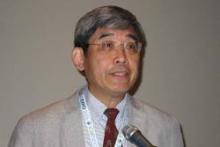CHICAGO – Two divergent pathways of hypothalamic-pituitary-testicular axis dysfunction underlie declining testosterone levels in aging men.
“There appear to be two separate tracks to primary hypogonadism marked by testicular dysfunction: secondary hypogonadism and compensated hypogonadism. Not only do they have different etiologies, they also have different clinical features and outcomes, and they therefore require different management strategies,” Dr. Frederick C. Wu said at the joint meeting of the International Congress of Endocrinology and the Endocrine Society.
He cited new data from the European Male Ageing Study (EMAS), a prospective observational cohort study of 3,369 community-dwelling men aged 40-79 years in eight countries. At baseline, they were categorized in four different biochemical classes: 78.4% were eugonadal; 9.6% had compensated hypogonadism marked by a normal serum testosterone level of 10.5 nmol/L or more but a serum luteinizing hormone value above 9.4 IU/L; 10.4% had secondary hypogonadism characterized by low serum testosterone and low serum LH due to pituitary or hypothalamic causes; and 1.7% had primary hypogonadism marked by a serum testosterone less than 10.5 nmol/L and LH greater than 9.4 IU/L due to a testicular condition.
Secondary hypogonadism is strongly associated with obesity and the development of symptoms of sexual dysfunction. Compensated hypogonadism is associated with aging but is independent of obesity. In EMAS, 2% of individuals with secondary hypogonadism progressed to primary hypogonadism during 4.3 years of follow-up.
Avoidance of obesity is “by far” the most important preventive measure to maintain normal testosterone in aging men; in EMAS, men who were not obese were 3.5-fold less likely to develop hypogonadism, Dr. Wu observed.
“Weight loss should be the first-line standard of care for obese men with low testosterone. The role of testosterone replacement remains unclear, and both modalities should be assessed in randomized controlled trials,” he said.
Dr. Wu added that he’d consider testosterone replacement therapy on a time-limited basis in patients with secondary hypogonadism unresponsive to lifestyle interventions. However, in patients with compensated hypogonadism, “there is no current indication for testosterone therapy.”
A key clinical message: Hypogonadism is a marker of poor health and increased mortality risk. During 4.3 years of prospective follow-up, the group with baseline primary hypogonadism had a 21% all-cause mortality rate, fourfold greater than the eugonadal group. Mortality was increased threefold in subjects with compensated hypogonadism and twofold in those with secondary hypogonadism, according to Dr. Wu, professor of medicine at the University of Manchester (England).
He focused particular attention on the group with compensated hypogonadism because this abnormality is a relatively new concept in endocrinology.
“It’s a concept similar to compensated hypothyroidism, but it hasn’t really been studied before to any extent in the gonadal axis,” Dr. Wu explained in an interview.
Compensated hypogonadism can be viewed as a transitional state during progression from eugonadism to primary hypogonadism. Affected aging men maintain normal testosterone levels by increasing their LH in order to compensate for testicular defects. Over a period of years, however, some of these men decompensate and progress to primary hypogonadism. In EMAS, this occurred at a rate of 1.4% per year. Compared with eugonadal men, men with compensated hypogonadism at baseline had a 10-fold greater risk of progressing to primary hypogonadism after adjustment for age, comorbid conditions, smoking status, and body mass index.
To date, no predictors of decompensation have been identified. However, elevated LH in older men with normal testosterone can be viewed as a highly sensitive biomarker for poor health and increased risk of mortality – and an opportunity for preventive intervention targeting cardiometabolic health, according to Dr. Wu.
The EMAS study was funded by the European Union. Dr. Wu reported serving on the speakers bureau for Bayer Schering Pharma.


